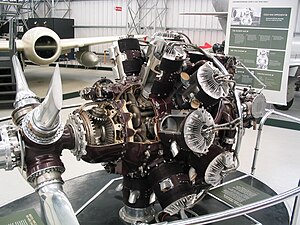Bristol Hercules
| Hercules | |
|---|---|
 |
|
| Cutaway Bristol Hercules engine at the National Museum of Flight, East Fortune, Scotland | |
| Type | Piston aircraft engine |
| National origin | United Kingdom |
| Manufacturer | Bristol Aeroplane Company |
| First run | January 1936 |
| Major applications |
Bristol Beaufighter Short Stirling Handley Page Halifax |
| Number built | 57,400 |
| Developed from | Bristol Perseus |
| Developed into | Bristol Centaurus |
The Bristol Hercules was a 14-cylinder two-row radial aircraft engine designed by Sir Roy Fedden and produced by the Bristol Engine Company starting in 1939. It was the first of their single sleeve valve (Burt-McCollum, or Argyll, type) designs to see widespread use, powering many aircraft in the mid-World War II timeframe.
The rationale behind the single sleeve valve design was two-fold: to provide optimum intake and exhaust gas flow in a two-row radial engine, improving its volumetric efficiency; and to allow higher compression ratios, thus improving its thermal efficiency. The arrangement of the cylinders in two-row radials made it very difficult to utilise four valves per cylinder, consequently all non-sleeve valve two- and four-row radials were limited to the less efficient two-valve configuration. Also, as combustion chambers of sleeve-valve engines are uncluttered by valves, especially the hot exhaust valves, being comparatively smooth they allow engines to work with lower octane number fuels using the same compression ratio. Conversely, the same octane number fuel may be utilised while employing a higher compression ratio, or supercharger pressure, thus attaining either higher economy, or power output. The downside was the difficulty in maintaining sufficient cylinder and sleeve lubrication.
Bristol had introduced their first sleeve-valve designs in the 750 horsepower (560 kW) class Perseus and the 500 hp (370 kW) class Aquila that they intended to supply throughout the 1930s. Aircraft development in the era was so rapid that both engines quickly ended up at the low-power end of the military market and, in order to deliver larger engines, Bristol developed 14-cylinder versions of both. The Perseus evolved into the Hercules, and the Aquila into the Taurus.
...
Wikipedia
